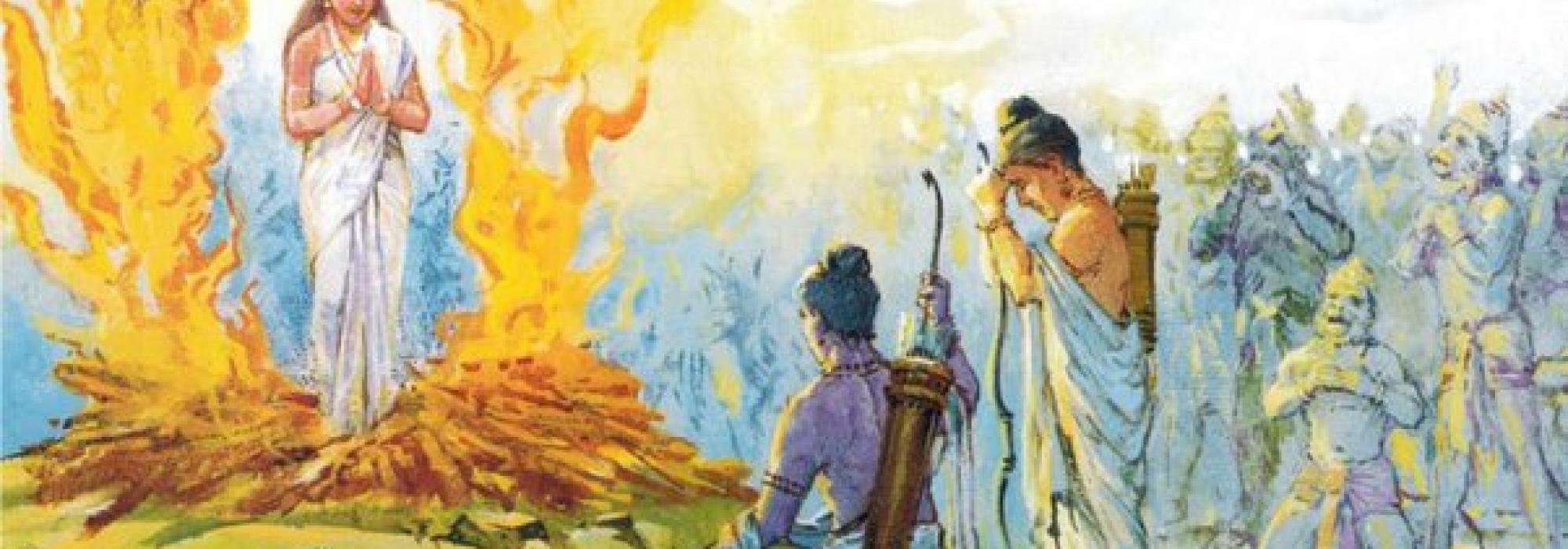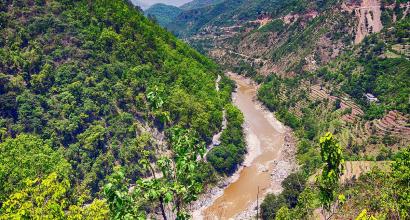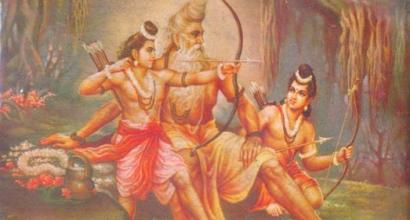Hanūmān told Rāma, “Queen Maithilī, who has been tormented by grief all this while, was overcome with immense joy upon hearing of your victory. She wishes to see her husband along with Lakṣmaṇa.” Rāma, who was addressed thus by Hanūmān appeared to turn gloomy and tearful. Heaving heavy sighs, he spoke to Vibhīṣaṇa staring at the ground. He said, “Have Sītā decked in divine ornaments and celestial unguents, with her hair freshly washed. Hurry!”
Thus instructed, Vibhīṣaṇa entered his antaḥpura and asked his women to convey Rāma’s instructions to Sītā. But Sītā replied, “I wish to see my husband without having bathed, O rākṣasa!” But Vibhīṣaṇa insisted that she carry out her husband’s wish. Sītā consented. Young maidens washed her hair and clothed her in beautiful garments. Vibhīṣaṇa got her mounted in a grand palanquin that was guarded by many rākṣasas and escorted her to Rāma.
Approaching the great man and noting that he was lost in brooding, Vibhīṣaṇa announced the arrival of Sītā. When Rāma heard that the lady who had dwelt in the house of the rākṣasa for so long had come to him, he was overcome with joy, helplessness, and anger – all three emotions at the same time. Rāma commanded Vibhīṣaṇa to bring Sītā to him at once. Vibhīṣaṇa cleared the area on all sides. Vānaras, ṛkṣas, rākṣasas, and all other beings drew back. As the large number of people were making space, there arose a sound like the roar of the ocean being whipped by a storm. But Rāma, looking at the great agitation that was being caused as people withdrew, was furious with Vibhīṣaṇa. He stopped him by saying, “These people are like my own kin. It is not houses, garments, high walls, or curtains that protect a woman; her virtuous conduct alone protects her. There is nothing wrong with a woman being seen in public in times of emergencies, wars, marriages, or during a yajña. Moreover, there is nothing wrong with her being seen, especially when she is in my company. Bring her to me at once. Let Sītā see me amidst my friends.”
Vibhīṣaṇa humbly obeyed Rāma. Lakṣmaṇa, Hanūmān, and Sugrīva were troubled to hear Rāma’s words. Looking at his pitiless demeanour, they thought that Rāma was displeased with his wife.
Compressing her body out of shame and covering her face with her veil, Sītā approached her husband. She wept as she murmured, “Āryaputra!” She, whose husband was her divinity, looked at the moonlike face of her husband with amazement, joy, and affection. Her sadness vanished as soon as she saw Rāma’s face, something she had not seen for a long time.
Looking at her, Rāma said, “Bhadre, you are here! I defeated the enemy in the battle through my valour and won you back. I have eliminated both the insult and my foe at the same time. Hanūmān’s leap across the ocean and razing of Laṅkā have borne fruit today. The efforts of Vibhīṣaṇa, who abandoned his evil brother and came to me of his own accord have become fruitful too.” As Rāma spoke these words, Sītā eyes were filled with tears. But Rāma continued to gaze at her in anger. With his eyebrows knitted, he stared at Sītā from the corner of his eye and spoke harsh words even as the vānaras and the rākṣasas were seeing, “I have accomplished everything that my valour and manliness would allow me to do. I have freed you from the hands of the enemy just as Agastya won over the southern regions with his tapas. I did not fight the war for your sake. I did so in order to protect my reputation and wipe clean the disgrace to my illustrious lineage. I have my doubts about your cāritra – character, and your presence has become disagreeable to me as is a bright lamp to a man with a diseased eye. You may go wherever you wish, daughter of Janaka! You have my permission. The ten directions are open to you and I have no further work with you. What kind of a man born in a noble family accepts a woman who had lived in the house of another man? You have slipped down from Rāvaṇa’s lap and have been subject to the glances of his evil eye; how can I take you back? I hail from a reputed family! I fought the war and won you back to protect the reputation of my family. I don’t love you anymore. You may go wherever you like. You may go to Lakṣmaṇa, Bharata, or Sugrīva if you please. Having been lustful about you, Rāvaṇa would not have left you untouched while you were in his place.”
When Maithilī, who deserved to hear sweet words, was spoken this way, she was badly shaken and shed tears. She felt shame being addressed that way by her beloved amidst the huge gathering; she had never heard such words before from anyone. She seemed to shrink within herself. Wiping her tear-stained face, she spoke to her husband in a soft, but faltering voice, “How can you, O valorous one, speak to me in such fashion? Your words are painful to the ears; your words are like those spoken by an indecent man to his ignoble wife. I am certainly not as you think of me and I swear by my cāritra! You seem to have developed suspicion about womanhood because of the misconduct of a few. You will give up your suspicion about me if you examine me closely. I came in contact with another’s body not of my own accord, but when I was in a helpless state; daiva – fate needs to be blamed in this regard. My heart over which I have always had control has always been devoted to you. But, I had no control over my body, it was in another’s hands! If you have forgotten our long mature love and still don’t trust me, I am surely lost forever. Why did you send your words of rebuke with Hanūmān who came to me as a messenger? I would have given up my life back then. You and your allies need not have suffered hardships in that case. You have given yourself to anger now like a base man; you treat me like a mere woman. Remember, I am the daughter of Janaka and was born from the earth itself. Have you forgotten the fact that you, as a young man, held my hand in yours, out of your own will? You have turned your back on my devotion and character!”
Sītā, still bitterly weeping, spoke to Lakṣmaṇa, who stood there helpless. She said, “Build me a pyre, Saumitri. I have no enthusiasm to live bearing these false accusations. I have been rejected by my husband in the presence of this large assembly; he does not trust my qualities and character. Entering fire is the only path favourable to me now.” Lakṣmaṇa, who was addressed in this fashion by Vaidehī, was overcome with anger and observed Rāma's face. But he understood Rāma’s intention through his stance and facial expression. He raised a pyre following Rāma’s intention.
Vaidehī, with her head hung low, slowly and reverentially went in a pradakṣiṇa around Rāma. She prayed to the devas and brāhmaṇas; with her hands joined in reverence, she said the following as she approached Agni, “Since my heart has never strayed away from Rāghava, may Agni, the sākṣī of the entire world protect me in every way.” With these words, she performed a pradakṣiṇa to Agni and entered its blazing flames with complete detachment. The huge crowd that had the aged and the children too, let out a defining cry of “Haa! Alas!” as they watched Sītā entire the fire.
While this was going on, Kubera, Yama, Indra, Varuṇa, Śiva, and Brahmā arrived at Laṅkā in their brilliant vimānas. They approached Rāghava and with their hands joined in reverence, they addressed him, “You are the creator of the entire universe and the most knowledgeable one. How can you disregard Sītā who is falling into the fire? In the past, you were Ṛtadhāmā, prajāpati of the Vasus. You are the eighth among the Rudras and fifth among the Sādhyas. The twin Aśvinīs are your ears; Sūrya and Candra are your eyes. You are the witness to the beginning and the end of the world. Yet, like an ordinary man, you ignore Vaidehī!”
When Rāghava was addressed thus by the devas, he said, “I consider myself a human, the son of Daśaratha. May bhagavān tell me who I am, who I belong to, and why I have come here.”
Brahmā replied, “You are the Supreme Divine Nārāyaṇa, the wielder of the cakra; you are the imperishable and absolute Brahman. You are Varāha – the primordial boar, Hṛṣīkeśa – the best of beings, and Kṛṣṇa – the all-powerful lord. You are the leader of all beings; you are intelligence, strength, forbearance, and self-control. You are Upendra, Madhusūdana, and Padmanābha. I am your heart, Rāma and your tongue is Devī Sarasvatī; you possess a thousand feet, a thousand heads, and a thousand eyes. You are the oṃkāra. No one knows your beginning and end. You had taken the form of Trivikrama in the past. Sītā is Devī Lakṣmī and you are Viṣṇu. You took up a human form to slay Rāvaṇa. Your purpose is now complete, please return to svarga. You are the ultimate refuge for all beings.”
Upon hearing the words of the pitāmaha, Agni with Vaidehī on his lap. Decked in ornaments of burnished gold and clad in red garments, Sītā looked dazzling like the rising sun. Her dark hair, garlands, and ornaments were unharmed; she looked unperturbed. Agni, the witness of all activities of the world, spoke to Rāma, “Here is your Vaidehī, Rāma. She has committed no papa through her words, actions, mind, or sight. She was abducted when you had left her alone. She always thought of you while in captivity. Though enticed and threatened in various ways, Maithilī’s heart never made a place for the rākṣasa. She is of pure character and you should accept her, Rāghava. I am commanding you and there is nothing more that needs to be said.”
Rāma said, “Sītā had to be subject to this test and proven innocent to the three worlds, as she had dwelt in the rākṣasa’s kingdom for a long time. If I had not put her to this test, the world would have said, ‘Daśaratha’s son Rāma is a lustful fool!’ I know well that Maithilī would love none other and is always devoted to me. But to prove to the world her character, I simply stood by as she entered fire. I wanted the world to have faith in her. Rāvaṇa could not have violated Sītā, who is always protected by her own tejas. She is inseparable from me just as is radiance from the Sun. Janaka’s daughter is proved flawless to the three worlds and I can never give her up. Moreover, all the revered and dear ones in the world have advised me so for my own good.”
Praised by his companions, Rāma reunited with his beloved. He enjoyed the happiness which he rightly deserved.
To be continued...
[The critically constituted text and the critical edition published by the Oriental Institute, Vadodara is the primary source. In addition, the Kannada rendering of the epic by Mahāmahopādhyāya Sri. N. Ranganatha Sharma and the English translation by Sri. N. Raghunathan have been referred.]
















































